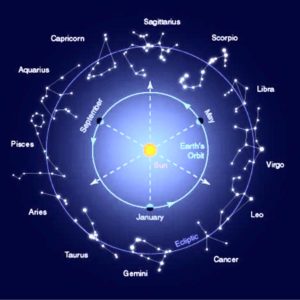 This is the last of our foray into astronomy, discussing the signs of the Zodiac. I will divide the 12 signs into two parts. What we, who live in the 21st century, must realize is that people from many different cultures have been looking at the heavens for thousands of year without the aid of telescopes, computer simulations, orbiting satellites or any of the “modern” technologies that have been developed since Ptolemy first categorized the heavens in 150AD. 99% of the population was illiterate and believed in all sorts of the supernatural. Only the religious leaders and nobility were educated. They held great sway in “reading the heavens”. As a result, each culture had different meanings for the objects they saw in the heavens. Each change of season or cosmic event had profound influences in their culture and daily life. However, we owe the greatest debt to the ancient Greeks and Romans. Their stories and legend live on today and maybe into eternity.
This is the last of our foray into astronomy, discussing the signs of the Zodiac. I will divide the 12 signs into two parts. What we, who live in the 21st century, must realize is that people from many different cultures have been looking at the heavens for thousands of year without the aid of telescopes, computer simulations, orbiting satellites or any of the “modern” technologies that have been developed since Ptolemy first categorized the heavens in 150AD. 99% of the population was illiterate and believed in all sorts of the supernatural. Only the religious leaders and nobility were educated. They held great sway in “reading the heavens”. As a result, each culture had different meanings for the objects they saw in the heavens. Each change of season or cosmic event had profound influences in their culture and daily life. However, we owe the greatest debt to the ancient Greeks and Romans. Their stories and legend live on today and maybe into eternity.
In ancient Greece, the signs of the Greek zodiac were identified with twelve groups of stars which we can see in the night sky at different times during the year, all lying on a pathway around the heavens. Remember Ptolomy called it the “ecliptic”. The ecliptic is further defined as the astronomical circle that tracks the Sun’s annual interaction with the Earth. Ancient astronomers measured the year by watching how the Sun makes an annual cycle against a backdrop of certain star-groups, and they defined the calendar according to the Sun’s progress along this circle. The word “zodiac”, comes from a Greek word meaning “the circle of animals”. With the exception of Libra, each one of the signs of the Zodiac is associated with living beings, either animals or humans. Most people believe that there are 12 signs in the Zodiac corresponding to the 12-month calendar. In reality there are 13 groups of stars along the elliptic. The reason for not including the thirteenth constellation, Ophiuchus, is not known; but it may be because ancient astrologers wanted to divide the 360-degree path of the Sun in a mathematically pleasing way – 12 equal parts, each of 30 degrees. Another reason is the belief that the 12 signs of the zodiac represent the 12 labors of Hercules.
In almost all cultures, spring held great reverence. So it is fitting we begin our journey along the path with Aries (March 21-April 20), as it is the first sign of the Greek zodiac, marking the beginning of spring and the start of a new cycle of life, a time of rebirth and fertility. Many celebrations occurred during the vernal equinox. The story of Aries is linked with the myth of the Golden Ram, which saved two kids, a brother and a sister, from being sacrificed in order to appease the gods. The fleece of the Golden Ram was said to have magical powers and was the basis for Jason’s quest for the Golden Fleece. Once Jason had completed his mission, Zeus put the ram’s golden fleece up in the skies, where it appears till today as the constellation of Aries.
The second sign of the Greek zodiac is the constellation of Taurus (April 21-May 21), associated with the legend of Theseus and the Minotaur. According to myth, Theseus volunteered to be one of the youths from Athens who would be offered as food to the horrible monster Minotaur (half man, half bull) who stayed in Crete, in the labyrinth. When he was there, with the help of Ariadne, the legendary hero managed to kill the beast and thus relieve his city, Athens, from the terrible punishment imposed by the Cretan king, Minos.
The constellation of Gemini is the third sign of the Greek zodiac. It by far my favorite myth. It is the story of the twin brothers Castor and Pollux. However, they were not twins in the ordinary sense, since they had different fathers. Their story starts when Zeus, king of the gods, wanted to have an affair with Leda, the lovely queen of Sparta. In order to fool her, he transformed himself into a beautiful swan and lay with Leda, (remember the constellation Cygnus). That same night she lay with her husband, Tyndareus, the king of Sparta. In the course of time, Leda bore two eggs: One of them contained a baby girl named Helen, the same one who later was the cause of the Trojan War, and a boy called Pollux. These two were the divine children of Zeus. The other egg opened up to reveal another girl and boy, Clytemnestra, who later became the wife of Agamemenon, the military leader of the Greeks in the Trojan War, and Castor. These were the mortal children of king Tyndareus, the legitimate husband of Leda. Despite the fact that one brother was divine and the other mortal, the twins Castor and Pollux grew to be inseparable. They did everything together and they loved each other dearly. Unfortunately, following a bitter fight that the twins had with other warriors, Castor was killed. Pollux was heartbroken and prayed to almighty Zeus to take his life as well, for he would not bear to live without his brother. Zeus was so touched by the twin’s love and affection for his brother, that he arranged for them to be together again. They could divide their time between the heavens and the Underworld, spending one day high up on Olympus and the next day beneath the earth.
The fourth constellation of the Greek zodiac known as Cancer (June 22-July 23), is linked with the second labor of the mighty hero Hercules, when he was assigned by Eurystheus to kill the Hydra, a horrible water snake with a hundred heads.
Leo (July 24-Aug.23), the fifth constellation of the Greek zodiac, is linked with Hercules’ very first labor, the capture of the Nemean Lion.
The sixth constellation of Virgo (Aug 24-Sept. 23) is associated with the story of Demeter and her daughter Persephone. For the ancient Greeks, the story of Demeter and Persephone helped to explain why the seasons change.
To be continued next time….











